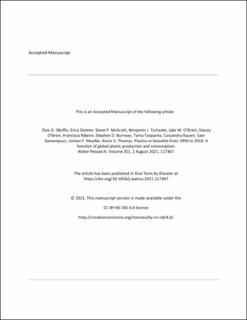| dc.contributor.author | Okoffo, Elvis D. | |
| dc.contributor.author | Donner, Erica | |
| dc.contributor.author | McGrath, Steve P. | |
| dc.contributor.author | Tscharke, Benjamin J. | |
| dc.contributor.author | O'Brien, Jake W. | |
| dc.contributor.author | O'Brien, Stacey | |
| dc.contributor.author | Ribeiro, Francisca | |
| dc.contributor.author | Burrows, Stephen D. | |
| dc.contributor.author | Toapanta, Tania | |
| dc.contributor.author | Rauert, Cassandra | |
| dc.contributor.author | Samanipour, Saer | |
| dc.contributor.author | Mueller, Jochen F. | |
| dc.contributor.author | Thomas, Kevin V | |
| dc.date.accessioned | 2022-07-13T13:40:08Z | |
| dc.date.available | 2022-07-13T13:40:08Z | |
| dc.date.created | 2022-02-09T17:21:06Z | |
| dc.date.issued | 2021 | |
| dc.identifier.citation | Water Research. 2021, 201, 117367. | en_US |
| dc.identifier.issn | 0043-1354 | |
| dc.identifier.uri | https://hdl.handle.net/11250/3005097 | |
| dc.description | Embargo until March 16 2023 | en_US |
| dc.description.abstract | Plastics are ubiquitous contaminants that leak into the environment from multiple pathways including the use of treated sewage sludge (biosolids). Seven common plastics (polymers) were quantified in the solid fraction of archived biosolids samples from Australia and the United Kingdom from between 1950 and 2016. Six plastics were detected, with increasing concentrations observed over time for each plastic. Biosolids plastic concentrations correlated with plastic production estimates, implying a potential link between plastics production, consumption and leakage into the environment. Prior to the 1990s, the leakage of plastics into biosolids was limited except for polystyrene. Increased leakage was observed from the 1990s onwards; potentially driven by increased consumption of polyethylene, polyethylene terephthalate and polyvinyl chloride. We show that looking back in time along specific plastic pollution pathways may help unravel the potential sources of plastics leakage into the environment and provide quantitative evidence to support the development of source control interventions or regulations. | en_US |
| dc.language.iso | eng | en_US |
| dc.publisher | Elsevier | en_US |
| dc.rights | Attribution-NonCommercial-NoDerivatives 4.0 Internasjonal | * |
| dc.rights.uri | http://creativecommons.org/licenses/by-nc-nd/4.0/deed.no | * |
| dc.title | Plastics in biosolids from 1950 to 2016: A function of global plastic production and consumption | en_US |
| dc.type | Peer reviewed | en_US |
| dc.type | Journal article | en_US |
| dc.description.version | acceptedVersion | en_US |
| dc.source.pagenumber | 7 | en_US |
| dc.source.volume | 201 | en_US |
| dc.source.journal | Water Research | en_US |
| dc.identifier.doi | 10.1016/j.watres.2021.117367 | |
| dc.identifier.cristin | 1999681 | |
| dc.source.articlenumber | 117367 | en_US |
| cristin.ispublished | true | |
| cristin.fulltext | postprint | |
| cristin.qualitycode | 2 | |

